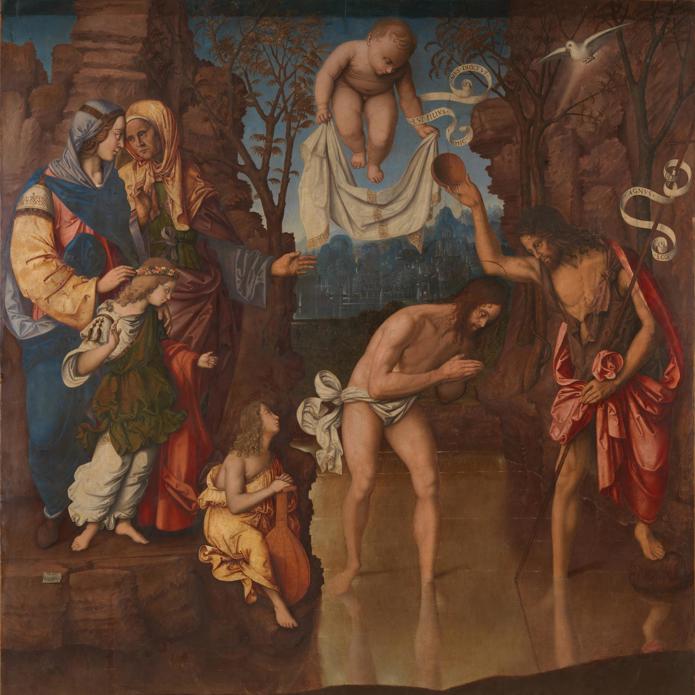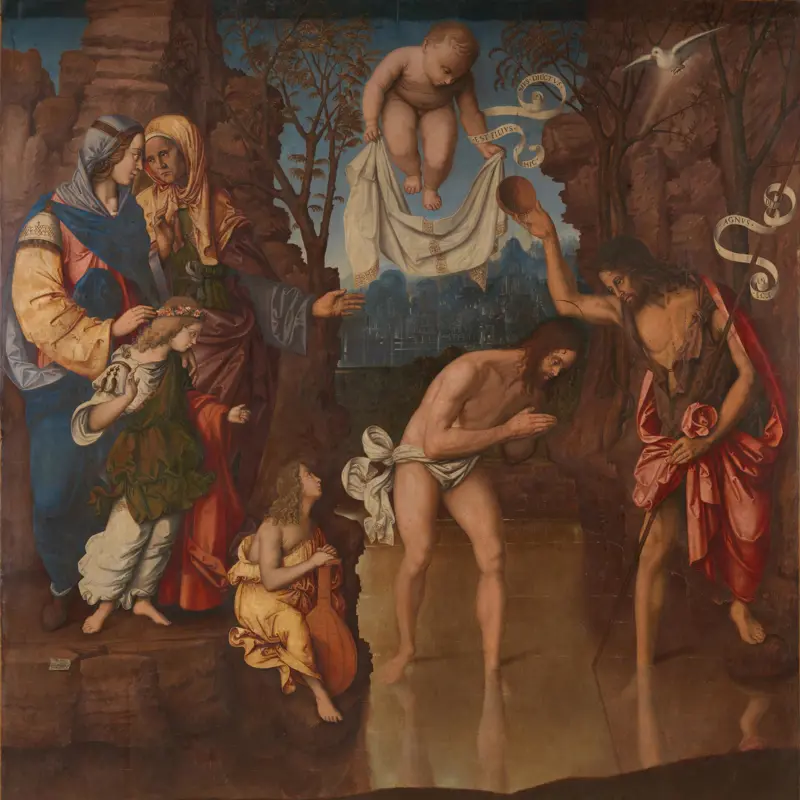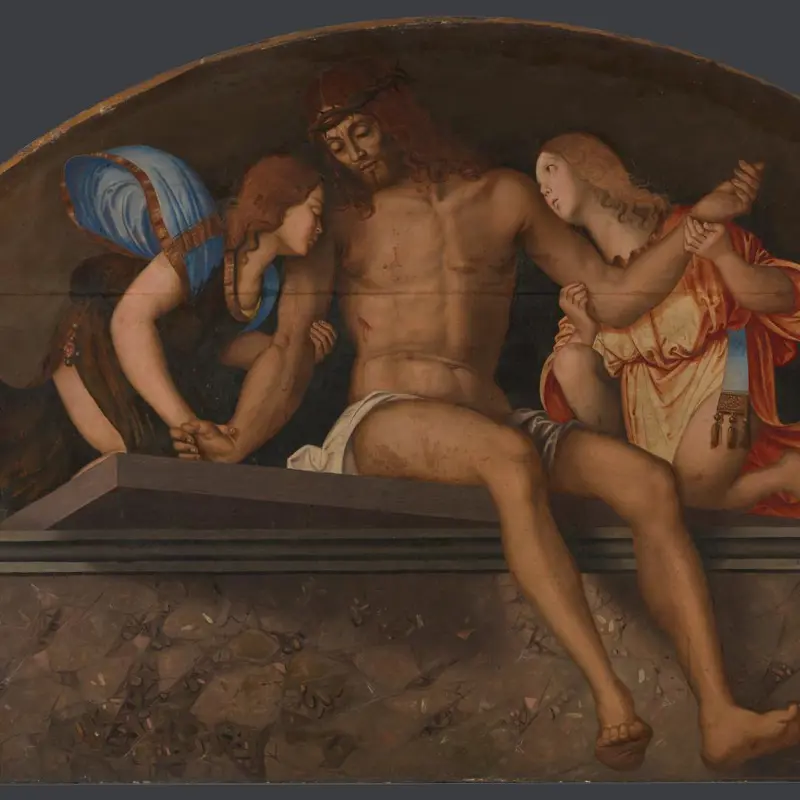Francesco Zaganelli, 'The Visitation with the Baptism of Christ', 1514
About the work
Overview
This is the main panel of an altarpiece painted for the chapel of the Visitation in the church of S. Andrea in Vineis, Faenza. A scroll inscribed ‘Ecce Agnus Dei’ (‘Behold the Lamb of God’) is attached to the reed cross that Saint John the Baptist holds. The inscription refers to Christ, who will be sacrificed like a lamb for the salvation of humanity. John pours water from a bowl onto the head of Christ, who clasps his hands in prayer and accepts God’s will. The other Latin inscription, held by the hovering baby with the cloth, translates as: 'This is my beloved Son’ (Matthew 3: 17).
The scene on the left of women accompanied by angels represents the Visitation – the encounter between the pregnant Saint Elizabeth and her cousin the Virgin Mary. Elizabeth, pointing to the main scene of Christ’s baptism, shows Mary the future encounter of their unborn sons. Combining both episodes in one painting was very rare at this time.
Key facts
Details
- Full title
- The Visitation with the Baptism of Christ
- Artist
- Francesco Zaganelli
- Artist dates
- Active 1499; died 1532
- Part of the series
- The Laderchi Altarpiece from San Domenico, Faenza
- Date made
- 1514
- Medium and support
- Oil on wood (probably poplar)
- Dimensions
- 200.7 × 190.5 cm
- Inscription summary
- Signed; Dated
- Acquisition credit
- Bought, 1924
- Inventory number
- NG3892.1
- Location
- Not on display
- Collection
- Main Collection
- Frame
- 21st-century Replica Frame
Provenance
Additional information
Text extracted from the ‘Provenance’ section of the catalogue entry in Giorgia Mancini and Nicholas Penny, ‘National Gallery Catalogues: The Sixteenth Century Italian Paintings’, vol. 3, ‘Bologna and Ferrara’, London 2016; for further information, see the full catalogue entry.
Bibliography
-
1962Gould, Cecil, National Gallery Catalogues: The Sixteenth Century Italian Schools (excluding the Venetian), London 1962
-
1987Gould, Cecil, National Gallery Catalogues: The Sixteenth Century Italian Schools, London 1987
-
2001
C. Baker and T. Henry, The National Gallery: Complete Illustrated Catalogue, London 2001
-
2016Mancini, Giorgia, and Nicholas Penny, National Gallery Catalogues: The Sixteenth Century Italian Paintings, 3, Bologna and Ferrara, London 2016
Frame
Made at the Gallery in 2015, this is a poplar wood reproduction frame in the style of seventeenth-century Northern Italian craftsmanship. It is based on the nineteenth-century lunette frame on Zaganelli’s The Dead Christ with Angels – the counterpart to The Visitation with the Baptism of Christ.
An acanthus-leaf and lamb’s-tongue motif adorns the back edge. The moulding features a torus-shaped frieze decorated with carved cabochons (egg-and-nest), each inset with flower heads. A lamb’s-tongue pattern embellishes the sight edge.
When the Gallery acquired The Visitation with the Baptism of Christ in 1924, it was framed in an architectural gilded moulding.
About this record
If you know more about this work or have spotted an error, please contact us. Please note that exhibition histories are listed from 2009 onwards. Bibliographies may not be complete; more comprehensive information is available in the National Gallery Library.
Images
About the series: The Laderchi Altarpiece from San Domenico, Faenza
Overview
These two panel paintings formed the altarpiece for the Laderchi chapel in S. Andrea in Vineis, Faenza (the church was rebuilt in the eighteenth century and rededicated as S. Domenico). The main panel represents two episodes from the New Testament: the Visitation of the Virgin Mary to her cousin Saint Elizabeth, who was pregnant with Saint John the Baptist; and the baptism of Christ in the river Jordan by Saint John the Baptist. The lunette, or upper panel, shows the dead Christ sitting on his open tomb, supported by two angels.
On 9 April 1504, Giacomo di Francesco Laderchi dictated a will in which he ordained that after his death his brothers should spend 100 lire in adorning the chapel of the Visitation, which he had paid to have built in 1489. Given the prominence of John the Baptist in this altarpiece, his brother Giovanni Battista was probably most closely involved in the commission.



